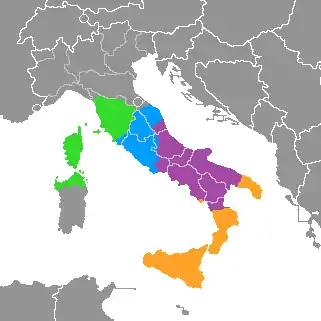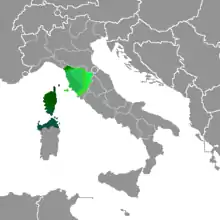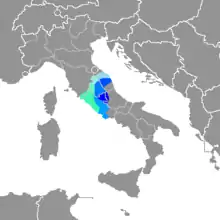Italo-Dalmatian languages
The Italo-Dalmatian languages, or Central Romance languages, are a group of Romance languages spoken in Italy, Corsica (France) and formerly in Dalmatia (Croatia).
| Italo-Dalmatian | |
|---|---|
| Central Romance languages | |
| Geographic distribution | Italy, France, Croatia |
| Linguistic classification | Indo-European
|
| Glottolog | ital1286 |
 | |
Italo-Dalmatian can be split into:[1]
- Italo-Romance, which includes most central and southern Italian languages.
- Dalmatian Romance, which includes Dalmatian and Istriot.
The generally accepted four branches of the Romance languages are Western Romance, Italo-Dalmatian, Sardinian and Eastern Romance. But there are other ways that the languages of Italo-Dalmatian can be classified in these branches:
- Italo-Dalmatian is sometimes included in Eastern Romance (which includes Romanian), leading to: Western, Sardinian, and Eastern branches.
- Italo-Dalmatian is sometimes included in Western Romance (which includes the Gallic and Iberian languages) as Italo-Western, leading to: Italo-Western, Sardinian, and Eastern branches.
- Italo-Romance is sometimes included in Italo-Western, with Dalmatian Romance included in Eastern Romance, leading to: Italo-Western, Sardinian, and Eastern branches.
- Corsican (from Italo-Dalmatian) and Sardinian are sometimes included together as Southern Romance, or Island Romance, leading to: Western, Italo-Dalmatian, Southern, and Eastern branches.
Languages
Based on criterium of mutual intelligibility, Dalby lists four languages: Corsican, Italian (Tuscan and Central Italian), Neapolitan–Sicilian, and Dalmatian.[2]
Dalmatian Romance
- Dalmatian language was spoken in the Dalmatia region of Croatia. It became extinct in the 19th century.
- Istriot language is a moribund variety spoken in the southwestern part of Istrian peninsula in Croatia.
Venetian
The Venetian language is sometimes added to Italo-Dalmatian when excluded from Gallo-Italic, and then usually grouped with Istriot. However, Venetian is not grouped into the Italo-Dalmatian languages by Ethnologue[3] and Glottolog,[4] unlike Istriot.[5][6]
Tuscan

- Tuscan-Corsican: group of dialects spoken in the Italian region of Tuscany, and the French island of Corsica.
- Northern Tuscan dialects:
- Florentine is spoken in the city of Florence, and was the basis for Standard Italian.
- Other dialects: Pistoiese; Pesciatino or Valdinievolese; Lucchese; Versiliese; Viareggino; Pisano-Livornese.
- Southern Tuscan dialects:
- Dialects of Aretino-Chianaiolo, Senese, Grossetano.
- Corsican, spoken on Corsica, is thought to be descended from Tuscan.[7]
- Northern Tuscan dialects:
Italian
- Italian is an official language in Italy, Switzerland, San Marino, Vatican City and western Istria (in Slovenia and Croatia). It used to have official status in Albania, Malta and Monaco, where it is still widely spoken, as well as in former Italian East Africa and Italian North Africa regions where it plays a significant role in various sectors. Italian is also spoken by large expatriate communities in the Americas and Australia. The Italian language was initially and primarily based on Florentine: it has been then deeply influenced by almost all regional languages of Italy while its received pronunciation (known as Pronuncia Fiorentina Emendata, Amended Florentine Pronunciation) is based on the accent of Roman dialect; these are the reasons why Italian differs significantly from Tuscan and its Florentine variety.[8]
Central Italian

- Central Italian, or Latin-Umbrian-Marchegian and in Italian linguistics as "middle Italian dialects", is mainly spoken in the regions of: Lazio (which includes Rome); Umbria; central Marche; a small part of Abruzzo and Tuscany.
- Romanesco, spoken in the Metropolitan City of Rome, Lazio. As mentioned above, it is the basis of the accent of the received pronunciation in standard Italian.
- Castelli Romani: spoken in the Castelli Romani, communes in the Metropolitan City of Rome, Lazio.
- Tuscia or Viterbo: spoken in the Province of Viterbo, Lazio.
- Ciociaro: spoken in Ciociaria, in the Province of Frosinone, Lazio.
- Umbrian: spoken in Umbria.
- Central Marchigiano: spoken in central Marche.
- Sabino: spoken in the city of L'Aquila (Abruzzo) and the Province of Rieti (Lazio).
Neapolitan

- Neapolitan language, or known in Italian linguistics as the " intermediate southern dialect group", is spoken in: southern Marche; southernmost Lazio; Abruzzo; Molise; Campania (including Naples); Basilicata; and the north of both Apulia and Calabria.
- Campano dialects of Neapolitan, Irpino, Southern Laziale: spoken in Naples and Campania; and southern Lazio.
- Abruzzese-Southern Marchigiano: spoken in the Abruzzo region and southern Marche region.
- Molisan: spoken in the Molise region.
- Basilicatine (Lucanian): spoken in the region of Basilicata, also known as Lucania.
- Pugliese or Apulian: spoken in the northern region of Apulia.
- Cosentino, also known as or Northern Calabrian:[9] spoken in the Province of Cosenza, in northern Calabria.
- Lu indialett di lu Uašt Spoken in the town of Vasto.
Sicilian

- Sicilian language, or known in Italian linguistics as the "extreme southern dialect group", is spoken on the island of Sicily; and in the south of both Calabria and Apulia; and in Cilento, in the southernmost of Campania.
- Sicilian proper, spoken on the island of Sicily: Western Sicilian; Central Metafonetica; Southeast Metafonetica; Ennese; Eastern Nonmetafonetica; Messinese.
- Sicilian dialects on other islands: Isole Eolie, on the Aeolian Islands; Pantesco, on the island of Pantelleria.
- Calabro,[9] or Central-Southern Calabrian:[9] dialects are spoken in the central and southern areas of the region of Calabria.
- Salentino, spoken in the Salento region of southern Apulia.
- Southern Cilentan: spoken in Roccagloriosa and Rofrano in southern tip of Cilento, which is southern Province of Salerno, in the Campania region.
- Cilentan: spoken in Cilento, influenced by both Neapolitan language and Sicilian language.
In addition, some Gallo-Italic languages are spoken in Central-Southern Italy.
Judeo-Italian
Judeo-Italian languages are varieties of Italian used by Jewish communities, between the 10th and the 20th centuries, in Italy, Corfu and Zakinthos.
References
- Hammarström, Harald & Forkel, Robert & Haspelmath, Martin & Nordhoff, Sebastian. 2014. "Italo-Dalmatian" Glottolog 2.3. Leipzig: Max Planck Institute for Evolutionary Anthropology.
- David Dalby, 1999/2000, The Linguasphere register of the world's languages and speech communities. Observatoire Linguistique, Linguasphere Press. Volume 2. Oxford. Archived 2014-08-27 at the Wayback Machine
- "Venetian". Ethnologue.
- "Venetian". Glottolog.
- "Istriot". Ethnologue.
- "Istriot". Glottolog.
- Harris, Martin; Vincent, Nigel (1997). Romance Languages. London: Routlegde. ISBN 0-415-16417-6.
- La pronuncia italiana (Italian). treccani.it
- Calabrian in Italian: Calabrese (pl. Calebresi). Synonyms: Calabro, Calabra, Calabri, calabre (m., f., m.pl., f.pl.). Sicilian: calabbrìsi, calavrìsi.